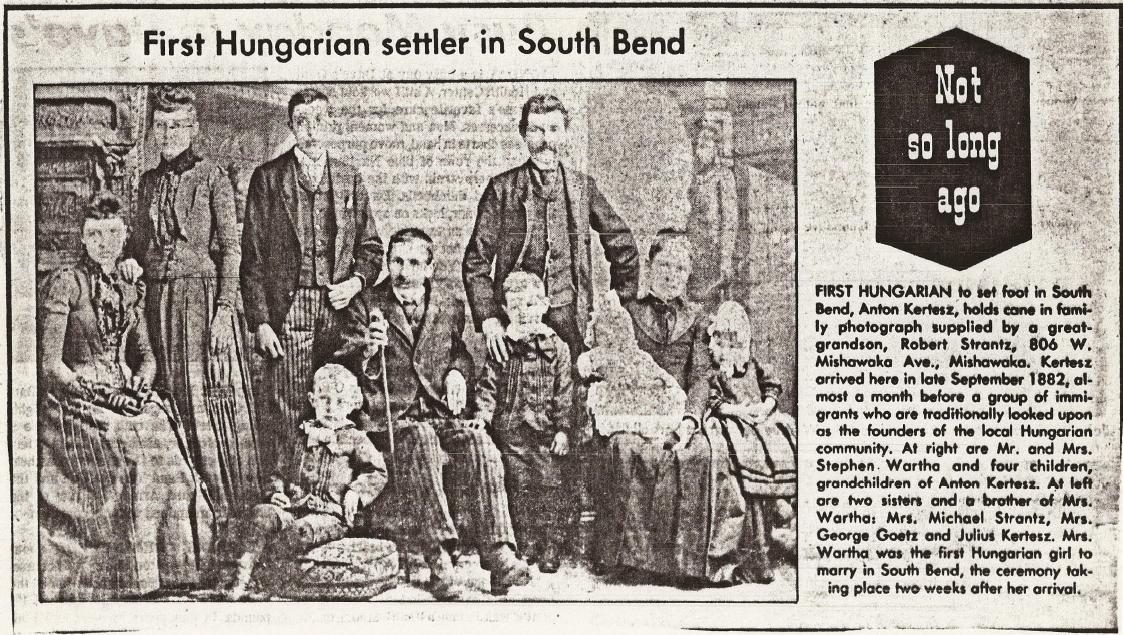|
The
|
||||||||||||||||||||||||||||||||||||||||||||||||||||||||||||||||||||||
THE BURGENLAND BUNCH NEWS - No. 206 January 31, 2011, © 2011 by The Burgenland Bunch All rights reserved. Permission to copy excerpts granted if credit is provided. Our 15th Year, Interim Editor: Thomas Steichen, Copy Editor: Maureen Tighe-Brown The Burgenland Bunch Newsletter is issued monthly online. It was founded by Gerald Berghold (who retired in Summer 2008 and died in August 2008). |
||||||||||||||||||||||||||||||||||||||||||||||||||||||||||||||||||||||
Current Status Of The BB: * Members: 1903 * Surname Entries: 6543 * Query Board Entries: 4534 * Number of Staff Members: 17 |
||||||||||||||||||||||||||||||||||||||||||||||||||||||||||||||||||||||
This newsletter concerns: 1) THE PRESIDENT'S CORNER 2) REVISED HISTORY OF THE SOUTH BEND HUNGARIANS (by Gary Gabrich) 3) GERRY BERGHOLD'S BURGENLAND LIBRARY RETURNS HOME 4) A NAME IS A NAME, RIGHT? 5) A BAKER'S TALE (by Donna Dunkel Kemp) 6) LINGUISTICS AND YOUR CROATIAN ROOTS (by Frank Paukowits) 7) END OF AN ERA, FOLLOW-UP 8) BACKLINKS - WEBSITES THAT LINK TO THE BB 9) HISTORICAL BB NEWSLETTER ARTICLES: - GERMANIC REGIONS OFTEN CONFUSED WITH THE BURGENLAND - VILLAGE NAMES CHANGE BUT RECORDS REMAIN 10) BURGENLAND JEWISH DNA GROUP (by Henry Sinai) 11) ETHNIC EVENTS (courtesy of Bob Strauch & Margaret Kaiser) 12) BURGENLAND EMIGRANT OBITUARIES (courtesy of Bob Strauch & Klaus Gerger) |
||||||||||||||||||||||||||||||||||||||||||||||||||||||||||||||||||||||
1) THE PRESIDENT'S CORNER (by Tom Steichen)  This
month we are again blessed with interesting articles contributed by BB members. This
month we are again blessed with interesting articles contributed by BB members. Donna Dunkel Kemp tells the story of her family of bakers who descended from Slovenian nobility, thus allowing her the double-titled name of Baronin Donna Freifrau von Buset zu Faistenburg (Baroness Donna Baroness from Buset to Faistenburg), which is much like the modern-day nomenclature, Doctor Doctor, used by Germans who hold two Ph.D. degrees! Gary Gabrich tells us about research performed by Kathleen Rosenthal, Nadine Hardin, Tom Wartha and himself concerning the first Hungarian emigrant to South Bend, Indiana. And Frank Paukowits follows up his October 2010 article on Tracing Your Croatian Roots with a different approach to discovering Croatian roots. Please let them know if you enjoy their stories. As you may recall, I did not publish a December newsletter. My time to create a newsletter was used up by lots of family affairs. My wife and I spent a week around Thanksgiving in Washington, DC, where our son and daughter-in-law live and where my youngest sister and her family have been for many years. I spent much of that week doing handyman work in the new flat my son recently purchased and a bit of it consoling my sister, who managed to shatter her upper arm in a household accident during the week before Thanksgiving (she's recovering fine but will now have a harder time getting through airport screening!). Despite that, it was a nice week... even the road traffic mostly cooperated. In the second week of December, my wife threw a 60th birthday party for me, with lots of friends and family consoling me on my advancing years ('twas my turn to be consoled)! This meant that we had to put up all the Christmas decorations earlier than usual (we usually put that off until after my birth day). For Christmas, we spent a week in New York City, taking the Amtrak train up from North Carolina. We visited with our other son (a freelance writer and editor there) and spent a day with BB staff member Frank Paukowits and his lovely wife Elsie, as well as doing the "city" at Christmas. We were also there for the blizzard! I don't know what the deal is, but this is the second year in a row we've endured a blizzard while traveling. Last
year, we were in Washington, DC, for the "snow-maggedon," so dubbed by the DC media. Luckily, we were there with our
4-wheel-drive Jeep, just shod with new tires, so we were able to get about the city while most vehicles were buried in
drifts. We even got to play "hero" by taking a pregnant mother (a friend of our son and daughter-in-law) to the hospital
to give birth! |
||||||||||||||||||||||||||||||||||||||||||||||||||||||||||||||||||||||
2) REVISED HISTORY OF THE SOUTH BEND HUNGARIANS (by Gary Gabrich, South Bend, IN) As we continue to research our ancestral history, we occasionally gather new facts that turn out to conflict with “known” history. Such was the case when I was proudly helping new BB member Kate Rosenthal, who lives in Montana, find her ancestors here in South Bend, one of whom turns out to be Anton Kertesz, identified as “the first Hungarian” in South Bend. Along the way, we recorded that his daughter Gizella (age 15) married a young man named Stephen Wartha within a few months of her arrival. This surname, Wartha, tickled my interest and, with a little prodding from Kate to press further, caused me to speculate that maybe there was more than a casual connection. The “bible” on South Bend Hungarian history is a publication issued in 1932 for the 50th anniversary of the Hungarian arrival. It is titled “During the First Half Century 1882–1932; the Golden Jubilee Album of the Magyar People in South Bend” and was written by Vendel Hajdu, the editor and owner of the local Hungarian newspaper, City Life. This book indicates that the Kertesz family was the first to arrive, via Baltimore in July 1882; they were the self-appointed advance team that would find accommodations and jobs. The rest of the group of 35 individuals arrived in October. 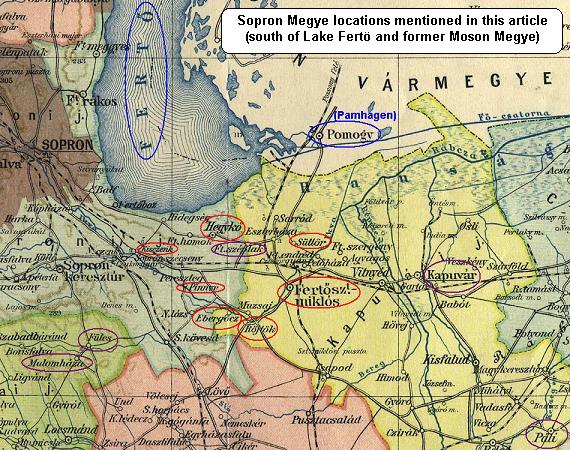 The
Kertesz’s were from Hegykö; others in the group were from neighboring villages such as Süttör, Fertöszentmiklós, Ebergöcz,
Pinnye, Kisczenk and Röjtök. This is an area relatively close to Vienna, where the agents for the Cunard Lines were
pushing ticket sales to the industrial cities of the Midwest in the USA, where jobs were plentiful for unskilled laborers.
You will notice from a map of Sopron County that the above villages [circled in red in map] cluster somewhat close
together at the south edge of Lake Fertö (now Neusiedler See), were adjacent to Moson County, and that the current border
crossing is at Pamhagen, which is only 5 miles from Süttör or 7 miles from Hegykö. The
Kertesz’s were from Hegykö; others in the group were from neighboring villages such as Süttör, Fertöszentmiklós, Ebergöcz,
Pinnye, Kisczenk and Röjtök. This is an area relatively close to Vienna, where the agents for the Cunard Lines were
pushing ticket sales to the industrial cities of the Midwest in the USA, where jobs were plentiful for unskilled laborers.
You will notice from a map of Sopron County that the above villages [circled in red in map] cluster somewhat close
together at the south edge of Lake Fertö (now Neusiedler See), were adjacent to Moson County, and that the current border
crossing is at Pamhagen, which is only 5 miles from Süttör or 7 miles from Hegykö.Quoting from the above book:
A paragraph later, we find:
In the next paragraph, we find:
We suspected that this meeting with the Wartha man was more than a coincidence and thus our search for his full
identity began. |
||||||||||||||||||||||||||||||||||||||||||||||||||||||||||||||||||||||
3) GERRY BERGHOLD'S BURGENLAND LIBRARY RETURNS HOME Ed Tantsits of Allentown, PA, one of the BB founding members, recently wrote to me, saying: "Hi Tom, Gerry Berghold's books now have a home. I went 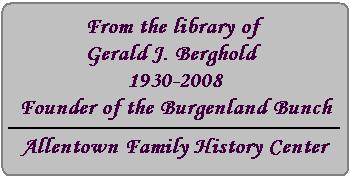 to
the Family History Center today to check on all the books I had given to the center. All the books are now on two large
shelves able to accommodate all the books. The books are now getting labels on the inside front cover as the one I have
attached. The labels are 2" X 4" in size. The books are not allowed to be removed from the library to be taken home. They
are to be read/researched at the center only. The people at the center were very happy and willing to accept the addition
of these books to their library. The library address is 1881 Van Buren Dr, Whitehall, PA." to
the Family History Center today to check on all the books I had given to the center. All the books are now on two large
shelves able to accommodate all the books. The books are now getting labels on the inside front cover as the one I have
attached. The labels are 2" X 4" in size. The books are not allowed to be removed from the library to be taken home. They
are to be read/researched at the center only. The people at the center were very happy and willing to accept the addition
of these books to their library. The library address is 1881 Van Buren Dr, Whitehall, PA."This was the culmination of a long process and I thank Ed for bringing it to completion. Prior to his death in August 2008, Gerry requested that the BB find a home for his collection of Burgenland-related books. The BB Staff considered numerous options but felt that placing the books in a library in the Lehigh Valley would both honor Gerry (he was born in Allentown in the Lehigh Valley) and place them where they would be most useful (the Lehigh Valley was an important destination for Burgenland emigrants). In August 2009, my wife and I stopped in Winchester, VA (where Gerry settled in retirement) to spend much of a day cataloging and boxing the books. Chris Berghold, Gerry's son, kindly allowed us access and 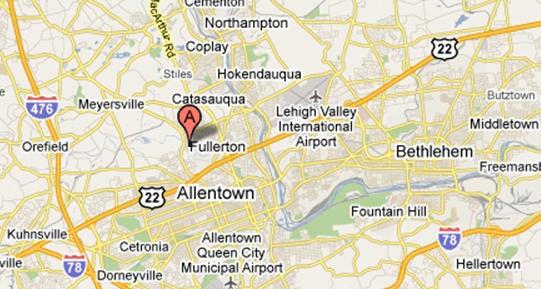 then
stored the books until May 2010 when we picked them up and dropped them off with Ed in Allentown. Ed took on the task of
finding a library that would appreciate and preserve the collection. As you can see, Ed placed them in the Allentown
Family History Center, 1881 Van Buren Dr, Whitehall, PA, where genealogical researchers in the
Allentown area can have easy access. then
stored the books until May 2010 when we picked them up and dropped them off with Ed in Allentown. Ed took on the task of
finding a library that would appreciate and preserve the collection. As you can see, Ed placed them in the Allentown
Family History Center, 1881 Van Buren Dr, Whitehall, PA, where genealogical researchers in the
Allentown area can have easy access. So, if you are in the area and visit the Allentown FHC, be sure to thank them for providing a home and access to this special collection of books. If you would like to see what is available, click here. I've also added a permanent link to this online catalog on the BB homepage (see "Gerry Berghold's Burgenland Library - Catalog" in the lower section of the home page). |
||||||||||||||||||||||||||||||||||||||||||||||||||||||||||||||||||||||
4) A NAME IS A NAME, RIGHT? BB member, Kathy Ettel Middendorf (Freeport, MN), sent a couple of emails to me recently concerning 1) transcription of "Houselists" and 2) possible changes in spelling of a surname. Kathy's husband, Mark, is a first cousin to my father through their mothers (the mothers were sisters with surname Zwilling, a name that does not come from Burgenland). Kathy, herself, just might be a distant cousin to me... but we haven't proven that yet. Nonetheless, we share a common ancestral surname, Öttl, which comes out of Halbturn. She writes (in part): Hi Tom, snow's a coming tomorrow, so I'm thinking ahead. Is that "Houselist" page still being actively worked on in BBunch? I noticed Halbturn has not been done, and I was wondering if that is something I could do "online". Or if not, I do have the records at the LDS in St. Cloud, if that is what one works off of. Let me know. Thanks. Also, is it possible that "Ottl" (as in your ancestor, Anna, and all of mine in Halbturn), could originally have been "Schotl", with an umlaut over the "o"? The reason I'm asking is that there have been a couple of suggestions to that extent mentioned to us, when we were in Halbturn - and that the Ottl's were originally from Mönchhof. And looking at the Houselist of Mönchhof, which has been done, I see there are still Schotl's there. It was hinted that the Ottl's came to Halbturn (from Mönchhof) when the castle there was completed. They were given the task/job of caring for the horses/stable of the royalty. But why they would have dropped the "sch", I would not know. But it is an interesting concept. Kathy [Note: Kathy had sent her message in the green color above, so I replied in color too (and have chosen to keep the colors to help you readers keep track of who is writing what).] I replied (in part): The "Houselist" is a project conceived and carried out by Klaus Gerger (given that, I have copied him on this reply; Hi Klaus!). It is still an active project and he is always looking for recruits to help transcribe the material. I looked on page http://www.the-burgenland-bunch.org/HouseList/HouseLists2.htm and note that he has (digital, I think) images of the Halbturn property records that need to be transcribed (I don't think LDS has these records). I'll ask Klaus to explain what needs to be done, etc. (so Klaus, please reply to Kathy!). Back to you Kathy... an interesting theory. I'd speculate Öttl is related to Otter (like an Otter, or something like that). Otter in German is the same word as the English otter, but also the word for an adder or viper snake. And Schöttl likely relates to Schotte, the German word for Scotsmen. So, if the two names were connected as you say, dropping the "Sch" would be a very large change in meaning... possible, yes, but it does not seem a likely change. Klaus, do you have any thoughts on this? [Note: Klaus replied to Kathy, copying me, but in boring black... but since I'm already using that color for my main text, I'll switch him to the following color.] Klaus replied (in part): Hi Kathy, every help for transcribing houselists is very welcome. You can see villages waiting to get transcribed on our houselist page. I plan to make digital copies of all houselists with (my) highest priority, because it is not clear how long access to the records will be allowed (or free of charge) by the Katastralmapenarchiv [Land Registry, Survey and Mapping Archive] office (I heard plans to reduce the space for visitors to a minimum). You can download the pictures for Halbturn from [he gave an address that I've redacted since the file is over 30MB in size]. Attached you can find an Excel template (is Excel OK?) for the data. Using the template makes it easier for me to bring it into a database and to do the publishing on a website. Give it a try. If you have any questions, just write an email, I'll be happy to answer. Concerning the name change: it would be unusual. What I found so far are different writings for the same pronunciation, lets say "kis Kiss kisch". So I agree with Tom. Being ever curious, I downloaded the large Halbturn file Klaus provided and looked at the images... in part, to see if my main Halbturner ancestor, Franciscus Weisz (Veis, Weiss) was listed as a property owner (he was not, but then half of the houses in Halbturn were owned by Archduke Albrecht of Austria, Duke of Teschen, as was Schloss Halbturn, and Franciscus likely worked for him all his life). The high-resolution pages Klaus provided were quite clear and easy to read (assuming you recognize a few German ligature characters). Halbturn covered just over 12 pages, with 20 entries per full page (this appears to be a fairly average size for a village, at least according to the project status pages found on the Houselist webpage mentioned above). Given that Klaus also provides a pre-formatted Excel spreadsheet to digitally record the data, this appears to be a fairly straightforward transcription project. If, like Kathy, you are looking for something to do while the snow is coming down this winter, please consider contacting Klaus to volunteer (email address here). Klaus' short second paragraph showed agreement in my thinking... names changed spellings mainly to match phonetically in different languages (though I have also seen changes to maintain meaning across languages). Given that Burgenland was a crossroads of many of nationalities and languages, there were lots of spelling changes too. Separate from Klaus' project, Kathy sent me a second email continuing the name-change discussion. It was just a one-line message but with an attached image. She said: "Don't know if you have seen this, but am wondering if that Stephan Odtl, listed on top, and then Stephan Etly listed on the bottom, could be the same person." What she sent me was a one-page extract from a 1999 village history of Halbturn written by Herbert Brettl (Halbturn - Im Wandel der Zeiten / "Halbturn - Through the Ages"). The page was titled "Besitzaufteilung --- 1673-1848 Wirtschaft," which translates to "Partition of Ownership --- 1673-1848 Economics." The page body was divided into two sections, with the upper section titled "Die ersten Besitzerlisten 1698" ("The first owners lists 1698"). That upper section consisted of four columns of names, with column headers as follows: 1. Ein ganzes Bauernhaus besaßen: (A whole farm owned:) 2. Ein halbes Bauernhaus gehörte: (A half farm owned:) 3. Söllnerhäuser gehörten: (Small-holder houses were:) 4. Briefhäusler waren: (Renters were: [but I could not find a good translation for this!]) The lower section was titled "72 Familien wohnen in Halbturn" (72 families live in Halbturn) and had explanatory text: "Eine Liste aus dem Jahre 1700 gibt einen hervorragenden Überblick über die Halbturner Bevölkerung und deren Besitzungem. So befanden sich in Halbturn:" (A list from 1700 gives an excellent overview of the Halbturner population and their owners. Thus were in Halbturn:). This lower section then split into two sub-tables that basically appeared to matched the first two columns of the top section. To make my point, I've placed the names from the first column from the top section (the owners of whole farms in 1698) in the table immediately below then "matched" the corresponding names from the lower section (i.e., the owners of whole farms in 1700).
What is interesting is that there is only a single name that matches exactly... and you must look closely
to see why I matched superficially different names as I did. I remind you that we are looking at names of farm owners (a
likely very stable group) recorded just two years apart! One might expect a little turnover... but not much... so most of
these are almost certainly the same individuals.
Here we do not find even a single name that matches exactly... many are close, but none exact. I've placed
question marks after the few that I think might be more questionable matches but, again, we see only two additional owners
of half farms and adequate match of the rest.
Martinus Regner, der eine ganzen Session bewirtschaftete, besaß: 6 Ochsen, 3 Kühe, 4 Pferde, 2 Stiere, 18 Schafe, 15
Anteile an Weingärten. Michael Snaider, der eine halb Session bewirtschaftete, besaß: 4 Ochsen, 3 Kühe, 2 Pferde, 2 Stiere, 14 Schafe, 10
Anteile an Weingärten. |
||||||||||||||||||||||||||||||||||||||||||||||||||||||||||||||||||||||
5) A BAKER'S TALE (by Donna Dunkel Kemp, Manheim, PA) 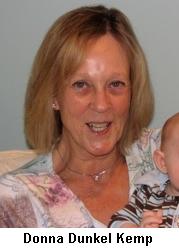 My
father, Joseph Peter Dunkel, Jr., was born September 15, 1915 on Glen Street in New Britain, CT. He lived there until the
family moved to the three-family house his father built on the hill at 767 Arch Street. Dad was a member of St. John's
Lutheran Church where he was baptized, confirmed and attended German classes. Upon graduation from New Britain High
School, he began his career in retailing with G. Fox & Company in Hartford, CT. My
father, Joseph Peter Dunkel, Jr., was born September 15, 1915 on Glen Street in New Britain, CT. He lived there until the
family moved to the three-family house his father built on the hill at 767 Arch Street. Dad was a member of St. John's
Lutheran Church where he was baptized, confirmed and attended German classes. Upon graduation from New Britain High
School, he began his career in retailing with G. Fox & Company in Hartford, CT.
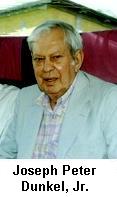 At
the start of WW-II, he enlisted in the Army. Some time before he was shipped overseas, he married Mary Dorothy Ambrose in
Lompoke, CA. He received three bronze stars, one each for his service in the D-Day invasion, the Battle in the Ardennes
Forest, and the Battle of the Bulge. His unit was then stationed in Berlin for two years. There, he attended the
University of Berlin to further his studies in German. At the end of the war, he returned to New Britain and resumed a
position with G. Fox & Co. Ultimately, he became the men's clothing buyer for all of the May Co. department stores in the
region and retired after 45 years of service. He also taught merchandising. In 1960 he moved his family to Newington, CT
where he resided for 39 years. He was an avid golfer, traveler, and an accomplished woodworker. He and his wife moved to
Lancaster, PA, in 1966 to be closer to their daughter, son-in-law and two grandsons. At the time of his death on November
28, 1997, he and Mary had been married for over 50 years. He was buried from St. Johns Lutheran Church in New Britain and
laid to rest in West Meadow Cemetery in Newington, CT. At
the start of WW-II, he enlisted in the Army. Some time before he was shipped overseas, he married Mary Dorothy Ambrose in
Lompoke, CA. He received three bronze stars, one each for his service in the D-Day invasion, the Battle in the Ardennes
Forest, and the Battle of the Bulge. His unit was then stationed in Berlin for two years. There, he attended the
University of Berlin to further his studies in German. At the end of the war, he returned to New Britain and resumed a
position with G. Fox & Co. Ultimately, he became the men's clothing buyer for all of the May Co. department stores in the
region and retired after 45 years of service. He also taught merchandising. In 1960 he moved his family to Newington, CT
where he resided for 39 years. He was an avid golfer, traveler, and an accomplished woodworker. He and his wife moved to
Lancaster, PA, in 1966 to be closer to their daughter, son-in-law and two grandsons. At the time of his death on November
28, 1997, he and Mary had been married for over 50 years. He was buried from St. Johns Lutheran Church in New Britain and
laid to rest in West Meadow Cemetery in Newington, CT.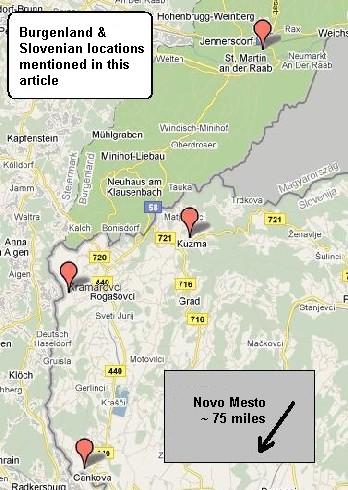 My
grandfather, Joseph Peter Dunkel (Josef My
grandfather, Joseph Peter Dunkel (Josef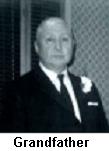 Peter Dunkl), was born in St. Martin a.d. Raab on March 13, 1891 and died on February 19, 1979 in New Britain, CT. His
family was Catholic; he worshipped and was buried from St. Peter’s Roman Catholic Church in New Britain.
Peter Dunkl), was born in St. Martin a.d. Raab on March 13, 1891 and died on February 19, 1979 in New Britain, CT. His
family was Catholic; he worshipped and was buried from St. Peter’s Roman Catholic Church in New Britain.Two immigration records have been found that might have referred to my grandfather. He traveled twice to America, first arriving May 10, 1907 from Gyanafalva (Jennersdorf), going to Allegheny, PA, on the SS Kaiser Wilhelm II, and then again in 1912. He briefly returned to Jennersdorf in 1912 and then immigrated to America permanently. By coincidence, my grandmother was at the train station in Graz or Jennersdorf when my grandfather returned from America. She told of the great excitement among his relatives. She did not know my grandfather or his family in Austria. My grandparents later met in New Britain, possibly at the Donau Club, and married. A record states: Josef Dunk?, age 21, baker, going to a cousin in New Britain, from Jennisdorf, arrived Nov. 29, 1912 on S.S. President Grant. Ship left Hamburg, Cuxhaven, Bologne-sur-Mer, Southampton, and arrived NY. It is known that he traveled to Pittsburgh, PA, and Milwaukee, WI, probably before settling in New Britain. Grandpa was a baker, as was his father in Austria. Initially he owed his own bakery that, unfortunately, was lost in the Great Depression. He then worked as a baker for the Mohegan Market in New Britain until he retired. Grandpa married Christine Fartek, probably in 1913 or 1914. 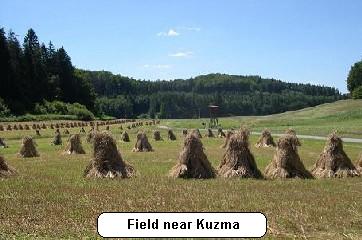 Grandma
came to the United States in 1912. She was born on January 8, 1897 in Kuzma, Hungary (now Slovenia) and died on October
30, 1989 in New Britain, CT. Her family was German Lutheran; she worshipped and was buried from St. John’s Lutheran Church
in New Britain. Grandma
came to the United States in 1912. She was born on January 8, 1897 in Kuzma, Hungary (now Slovenia) and died on October
30, 1989 in New Britain, CT. Her family was German Lutheran; she worshipped and was buried from St. John’s Lutheran Church
in New Britain.Both of my grandparents belonged to the Austrian Donau Club in New Britain. They are buried in Fairview Cemetery in New Britain. Little is known about my grandmother’s family. However, much is known about my grandfather’s family. For this, I thank my cousin Eduard Hütter in Jennersdorf, Austria, as well as George and Elisabeth Mandl in Pittsburgh, PA. My grandfather’s father was Peter Dunkl. He was born on February 21, 1863 in St. Martin a.d. Raab and died on February 21, 1892 in Jennersdorf where he was buried. Peter Dunkl first established a 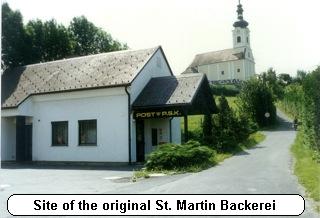 Bäckerei and Gasthaus in St. Martin and later moved the Bäckerei to Jennersdorf. The original buildings are still standing
in St. Martin a.d. Raab and in Jennersdorf.
Bäckerei and Gasthaus in St. Martin and later moved the Bäckerei to Jennersdorf. The original buildings are still standing
in St. Martin a.d. Raab and in Jennersdorf.After Peter’s death, his wife, Aloise Zotter, married Florian Hütter. They had a son, Eduard Hütter, born November 25, 1896, who was my grandfather’s half brother. One of Eduard’s sons, Alfred Hütter, continued to run the backerei. It then passed on to one of his sons, Eduard Hütter. The Bäckerei was greatly expanded at least twice under his leadership. Today Eduard’s sons, Thomas and Florian, continue to run the business. Thus, the family Bäckerei, begun with Peter Dunkl, has been in operation for more than 100 years. More information about the Bäckerei can be found on the website: www.baeckerei-huetter.at/. 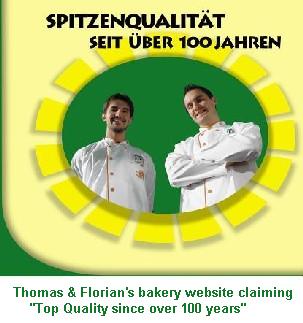 My
grandfather’s mother, Aloise Zotter, was born on July 20, 1868 (1868 in grandfather's handwritten chronicles but 1869 on
the gravestone) and died in 1949. Aloise was the daughter of Baroness Anna Busetti (also known as Buset) and Franz Zotter. My
grandfather’s mother, Aloise Zotter, was born on July 20, 1868 (1868 in grandfather's handwritten chronicles but 1869 on
the gravestone) and died in 1949. Aloise was the daughter of Baroness Anna Busetti (also known as Buset) and Franz Zotter.The Buset (other spellings include Busetti, Buseth, Busetto, Busegh and Buzetti) family descended from Jakob Buset, who was born in 1590 near Novo Mesto, Slovenia. He was the town judge in Rudolfswerth (Novo Mesto, in southern Slovenia), which is something like a mayor and judge, as well as a rich merchant. Jakob was appointed to the nobility by Kaiser Ferdinand III in 1692 and also Reichsritter (his title was Reichsritter Elder von Buset). On October 15, 1799 the Busets were raised into the Freiherrenstand (Baron of) by Franz I. The Busets were estate owners, high officials under the Kaiser, officers of the royal army, and church officials. Ignatius Cajetanus von Buset zum Faistenburg was Bishop of Trieste from 1796-1903. Leopold von Buseth was Abbott of Mariabrunn. The Buset family owned the estates of Volavce, Grazarjev Thurn, Strobelhof and Gabin. 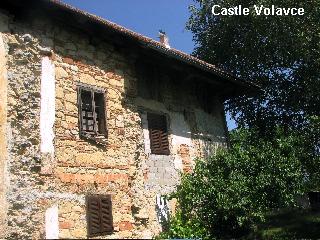
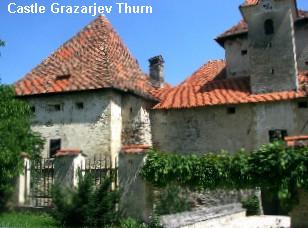 Castle Volavce was destroyed by the partisans in 1943 and later rebuilt. Grazarjev Thurn is still standing, but is in very poor condition. It now belongs to a Belgian family and is being restored by the Slovenian government. My cousin, Eduard Hütter, has been unable to locate the others. Anton von Buset, born in 1706, was a captain in the Batthyány regiment and stationed about 20 km from Jennersdorf and also in Kaltenbrunn 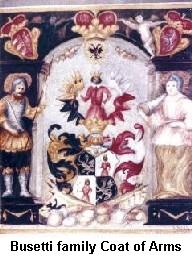 (now
Cankova), where he married a commoner. His son, Franz Janos, married and moved to Sinnersdorf (now Kramarovci), which is
close by. (now
Cankova), where he married a commoner. His son, Franz Janos, married and moved to Sinnersdorf (now Kramarovci), which is
close by.My grandfather’s great-grandparents were Franz Zotter and Baroness Anna von Busetti. They were married on July 15, 1827 in St. Martin a.d. Raab, according to records in the parish of Sveti Juri. No one knows what brought them to St. Martin a.d. Raab, although our family apparently did have a connection with Graf Batthyány; my aunt, Christine Dunkel Hartz, spoke of a marriage into this family. The Batthyány are still large landowners in the area around St. Martin a.d. Raab and Jennersdorf and maintain ownership of the Batthyány Castle as well. There are still gravestones of some family members in the cemetery in St. Martin a.d. Raab: Emma Zotter (married to Mandl) and Maria Jauk, nee Baronin Busetti (born 1800). The Hütter family plot is in the cemetery in Jennersdorf. Other names linked to my family besides Hütter, Zotter and Mandl are Windish, Mauser and Maier. Donna Dunkel Kemp Baronin Donna Freifrau von Buset zu Faistenburg |
||||||||||||||||||||||||||||||||||||||||||||||||||||||||||||||||||||||
6) LINGUISTICS AND YOUR CROATIAN ROOTS (by Frank Paukowits, Queens, NY) Linguistics is the study of human language. The Croatian language in Burgenland is particularly intriguing for linguists because of the multiplicity of dialects and the isolation of the language from its origin in Croatia, which is more than a hundred miles away from Burgenland. As a result, the language has been thoroughly researched. Burgenland Croatian (BC) consists of three main dialects: Štokavian, Čakavian and Kajkavian. Also, there are a number of subgroups (e.g., Haci and Poljanci and Dolinci) that fall under the umbrella of the Čakavian dialect. About 80% of Burgenland Croats speak the Čakavian dialect. Following is a map showing the dialects spoken in the towns of Burgenland with sizable Croatian populations [source: Burgenland Croatian Center; http://www.hrvatskicentar.at/images/landkarte.JPG; modified for clarity and English language]. 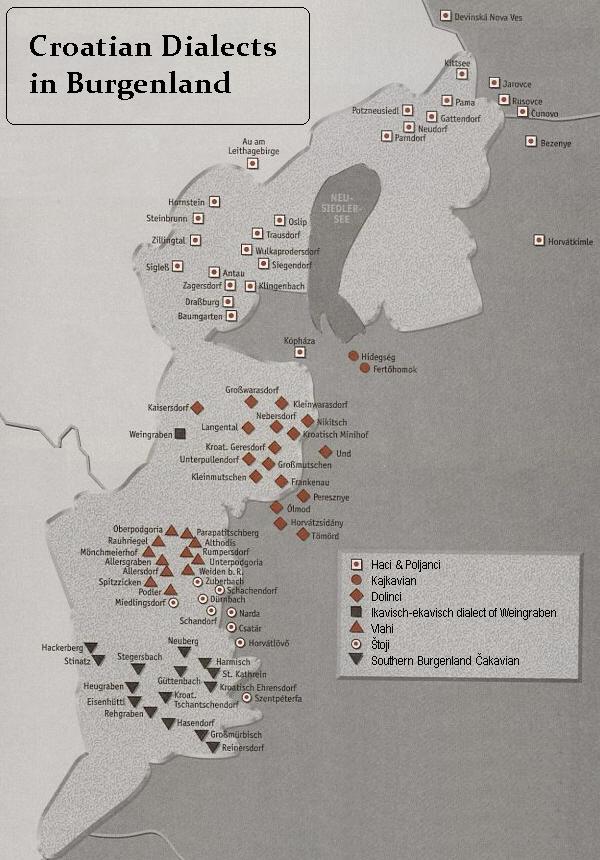 In
total, there are 73 towns where Croatian is spoken extensively. For the most part, the towns are grouped in such a way as
to form distinct islands with identical dialects. For example, in the south around Güssing, the
Čakavian dialect of southern Burgenland is spoken in most of the towns. In contrast, in the north the prevalent
subdialects are Haci and Poljanci. In
total, there are 73 towns where Croatian is spoken extensively. For the most part, the towns are grouped in such a way as
to form distinct islands with identical dialects. For example, in the south around Güssing, the
Čakavian dialect of southern Burgenland is spoken in most of the towns. In contrast, in the north the prevalent
subdialects are Haci and Poljanci.This pattern suggests that, within each group, there may have been a common geographical area from which migration to Burgenland occurred. Likewise, one might deduce that, from group to group, migration had occurred from different geographical areas because of the differences in dialects. This is one area that linguists have focused on in their research. Much of the research has been summarized in languages other than English. However, there are some exceptions. Namely, some of the research done by the International Congress of Slavists (ICS) has been presented in English. The ICS is made up largely of professors specializing in Slavic languages. They meet regularly and publish an annual summary of the research that is done. As noted previously, most of the material is in languages other than English; however, the work done by the Dutch researchers have been routinely presented in English. I was able to locate the findings of the Dutch researchers on the internet that were presented at the Fourteenth Meeting of the ICS in 2008 [Houtzagers, Peter. "On Burgenland Croatian Isoglosses." In "Dutch Contributions to the Fourteenth International Congress of Slavists," Ohrid: Linguistics (SSGL 34) Amsterdam - New York, Rodopi, 293-331, edited by Peter Houtzagers, Janneke Kalsbeek, Jos Schaeken]. The research dealt specifically with the issue of the place of origin of the Burgenland Croats. The researchers’ conclusion was that the Croats who ended up coming to Burgenland came from a relatively narrow band (area) in Croatia. This conclusion was based on the facts that the various dialects that are spoken in Burgenland today were also prevalent in the area in the 16th Century and, secondly, that the Croatian dialects of the migrants had many common elements, which suggests that all these people were neighbors at the time of the influx into Burgenland. Following is a map that was included in the research paper that shows the area from which linguists believe the migration occurred. 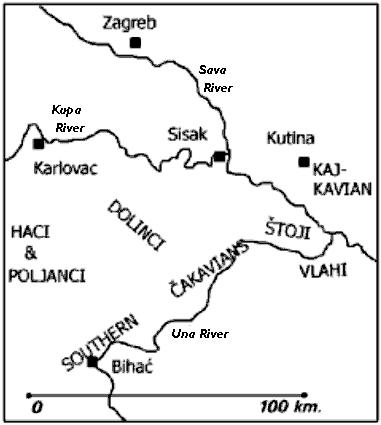 Indeed,
the area of exodus identified by the linguists matches up favorably with the historical references in Dobrovich’s book
[People on the Border - Destiny and Mission: On the History of the Burgenland Croats. 1963], however, Indeed,
the area of exodus identified by the linguists matches up favorably with the historical references in Dobrovich’s book
[People on the Border - Destiny and Mission: On the History of the Burgenland Croats. 1963], however,
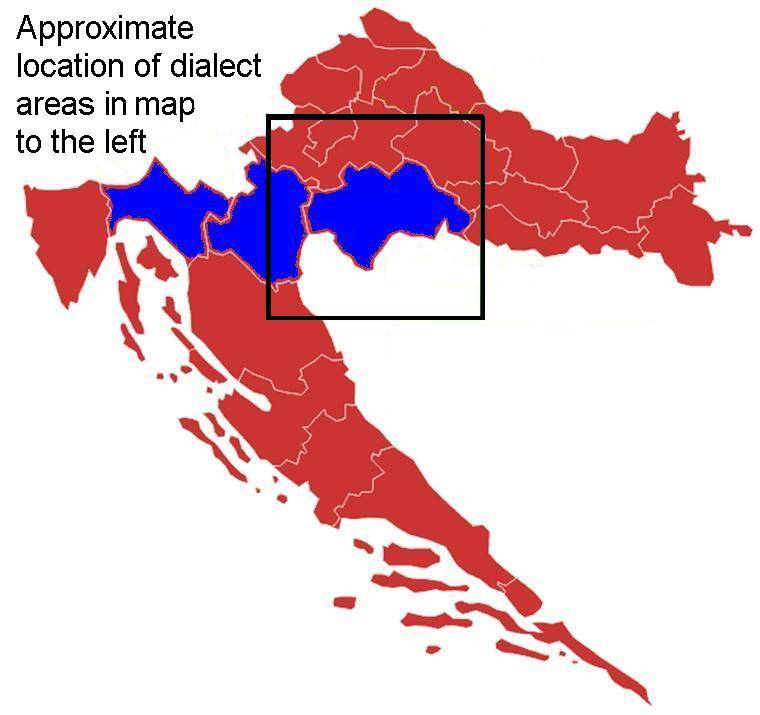 not
totally. Dobrovich’s book may have provided an accurate account of the original influx of Croats into certain towns, but
not necessarily a complete picture of the migration process over the entire settlement period. Towns did not spring up in
their entirety overnight. The process often took many years before the towns were completely settled. not
totally. Dobrovich’s book may have provided an accurate account of the original influx of Croats into certain towns, but
not necessarily a complete picture of the migration process over the entire settlement period. Towns did not spring up in
their entirety overnight. The process often took many years before the towns were completely settled.Also, it should be noted that the migration journey may have been completed in phases. Dobrovich talks of the resettlement of Croats from the area around Kostanjica to Hrastovica near Sisak in Croatia and then, subsequently, to Burgenland from there. Additionally, the Vlahi migration from the coastal areas may not have been directly to Burgenland but initially to other places in Croatia and Bosnia. The Dutch researchers identify what appears to be northern Bosnia as an area where Vlahis were present in the 16th century. As a result, the Vlahis may have entered Burgenland in the 17th century via northern Bosnia rather than from their original enclaves in coastal Dalmatia. Where does this leave us? I think we will never know for sure exactly where our Croatian ancestors came from. But I do believe, as we piece together all of the evidence, we get a better understanding of the process as it unfolded and, hopefully, greater accuracy on pinpointing the general location from which our Croatian ancestors emigrated. |
||||||||||||||||||||||||||||||||||||||||||||||||||||||||||||||||||||||
7) END OF AN ERA, FOLLOW-UP BB Member, Joe Jarfas (Equinunk, PA) wrote to say: Hi Tom and Frank, in your last newsletter I found Frank's essay ["End of an Era" by Frank Paukowits, concerning disbandment of the American-Burgenland Sick and Death Benefit Society in Passaic, New Jersey] especially interesting, since I'm searching for a similar society ...in Vermont. A researcher in Hungary contacted me to help find her something about her great grandfather, who arrived here in 1910 and, by 1916, he was dead. Ship records show he was heading to Proctor, VT. I never heard about the 'famous' Proctor marble mines, so it was a big surprise for me to find so many Hungarians there. 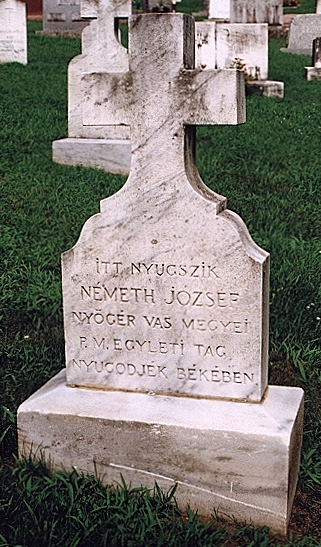 With
the help of local researchers I was even able to locate his headstone in the local cemetery. With
the help of local researchers I was even able to locate his headstone in the local cemetery.To make a long story short, the inscription on the stone mentions a 'member of P.M.' society of sort [P.M. Egyleti Tag = P.M. Society Member], which we assumed it had to be some kind of sick and benevolent society, but no such (registered) organization could be found. The consensus was that it had to be, maybe, a Proctor Mason club, but querying them did not produce any records. And this brings me back to Frank's story: do you know what's going to happen to their records? Did they mention any intent to deposit them in a local library, archives or anywhere? I was also asked to see if I can find out how our man sent the money home to his wife and children? I assume many of these organizations maintained a sort of 'postal' or banking service, because the great granddaughter found a savings book cover but the crucial 'detail' pages were missing. In my case, the Vermont state archives, local librarian and the local registrar were very helpful; and the fact that I was able to locate a headstone after all these years is even more remarkable. He spent ten days in the hospital, but no hospital records could be found (and that's the case with almost all hospitals all over the world). So, just for future genealogists' sake try to find out what the American-Burgenland Sick and Death Benefit Society of Passaic, NJ will do with their records of those long fruitful years. Frank Paukowits replied: Hi Joe, I received your e-mail and I am going to forward it on to the Secretary of the Club, who has whatever records are still available. I think your point is valid; however my guess is that the organization has not even thought about this matter. I will get back to you with any further details, when and if they are forthcoming. I also replied (in part): Hi Joe, thanks for bringing this to our attention. I saw Frank's reply (that he will follow up with the Passaic society), so that is good. This "PM" society rings no bells with me but what I can do is offer to run your story in our next newsletter (end-of-January). Perhaps one of our readers will recognize it. I'm also curious whether the savings book cover mentioned more... did it not identify the organization at all? Likewise, you do not mention any church affiliation; did you pursue those type of records and could the membership been with a church-based group? Joe followed up, saying: Don't see, Tom, any problem with running this story in the next newsletter. Maybe we can get some ideas from the other BB members too (not to speak of the fact that this story also 'belongs' to county Vas). Your hint to pursue local church groups is a good one! :-) After all P.M. could stand for Proctor Methodists too. Just the fact he has a marble headstone implies either his company ordered it, or a sick and death benefit society paid for it. So far, company records elude me also. Years ago, when I was searching for my wife's ancestors, I stumbled upon a group whose ancestors all had a Rudd line in them (as does my wife). As soon as I told them what I had, they were extending my wife's line four or five generations! ;-) But one great surprise was they located, while I was with them, a turn-of-last-century researcher for that line who deposited all her papers in a library in a remote little village somewhere, and somebody just found them. We all paid the librarian to make us copies - a few hundred pages - and were able to confirm most of the latest research results as well as found other sources of data nobody knew about. So, just emphasize, whatever you add to this story, that old homesteads (and 'left-overs') should not be just 'cleaned out,' but sorted and saved. Might have to give a few bucks 'donation' to the local archive or library to hold on to those old boxes ...but eventually somebody comes along for whom it will be a treasure! ;-) I couldn't agree more... which is why I put effort into helping Gerry Berghold's Burgenland library find a home (see article 3 above). Please do find a permanent home for all the research you have done and for those records that support your findings! 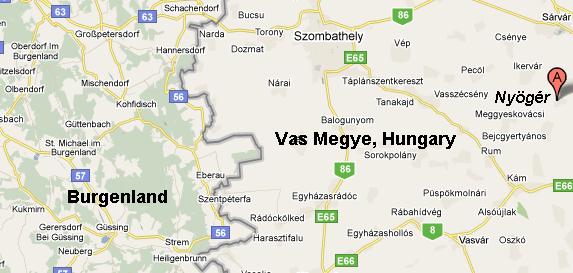 Joe
is also right that "this story also 'belongs' to county Vas." You should note, on the headstone above, the line "Nyögér
Vas Megyei," which, almost certainly, refers to the birthplace of József Németh. Nyögér stills exists by that name and is
in current-day Vas Megye, about 35 km east of the Burgenland border. Joe
is also right that "this story also 'belongs' to county Vas." You should note, on the headstone above, the line "Nyögér
Vas Megyei," which, almost certainly, refers to the birthplace of József Németh. Nyögér stills exists by that name and is
in current-day Vas Megye, about 35 km east of the Burgenland border.A few days later, Joe replied again (in part): With regard to the savings book cover: it was
issued to the wife of József Németh in Sárvár, but neither date nor the name of the institution could be read. She is
searching the archives in Szombathely to find relevant material on the bank. |
||||||||||||||||||||||||||||||||||||||||||||||||||||||||||||||||||||||
8) BACKLINKS - WEBSITES THAT LINK TO THE BB As you know, the BB has a whole section dedicated to pointing out and providing links to websites of interest to Burgenland researchers. In fact, we have always had a staff member dedicated to maintaining our URL/Links page, http://www.the-burgenland-bunch.org/Links/links.htm. Anna Kresh started the list and maintained it until Alan Varga took it over after her retirement. (My thanks to both of them!) However, what you might not know is that we recently added a "BackLinks" page at http://www.the-burgenland-bunch.org/Links/backlinks.html. This is a page that keeps track of the websites that think enough of the BB that they choose to have a link on their site pointing to us. You might ask why we would bother tracking these backlinks? The simple answer is that, if they are going to bother having a link to us, we want to make sure it is correct. As you may recall, we moved the BB website to our new domain (www.the-burgenland-bunch.org) in August of 2010 ...and that broke all the links pointing at us! After we brought up the new site, we turned to getting these backlinks fixed... and that proved a lot tougher than we imagined. Who do you contact at a site? How do you contact that person (email address, online contact form, via phone, etc.)? And how do we track such contacts to completion? Klaus Gerger suggested we start a page to hold the needed information and to track progress on getting backlinks fixed. That way, we have the information if we need it again in the future and we know where we are at in the process. Klaus drafted the page then Alan Varga made slight modifications and took it on as part of the Links effort. If you peek at that page, you'll see we are aware of 18 websites with links to us and we have succeeded in getting 8 of them fixed. However, that leaves 10 yet to go, even though we have contacted all of them at least once (and many of them more than once). I was reminded of this effort in December when Frank Paukowits wrote to ask if I was aware of the site http://www.usaustrians.com/ and the fact that it had a link pointing to our prior domain name. In fact, I was aware of that site but not that they linked to the BB (much less that the link was now wrong). I immediately checked it out, requested that they fix the broken link, then passed along the information to Alan to add to our file and track progress. I had barely hit 'send' on my message to Alan when I received a reply from Guenther Edelsbacher, webmaster of the USAustrians site, telling me that the link was fixed! Not only that, he provided me with a user name and password allowing me to update or add information about the BB whenever I want! This speed of response and flexibility was so unusual that I decided to look further at the site. USAustrians declares themselves to be "the free social website for all Austrian  Companies
and Organizations in the USA who want to show who they are and what they do." Without a doubt, Guenther provides this
site, in part, to drive business to his company, Edelsbacher Design Group, which is an advertising and website design
agency, but he also does it as a labor of love to crosslink Austrian-based companies and organizations and to allow them
to provide support and advice to each other as they try to establish themselves in the US. I commend him for his efforts! Companies
and Organizations in the USA who want to show who they are and what they do." Without a doubt, Guenther provides this
site, in part, to drive business to his company, Edelsbacher Design Group, which is an advertising and website design
agency, but he also does it as a labor of love to crosslink Austrian-based companies and organizations and to allow them
to provide support and advice to each other as they try to establish themselves in the US. I commend him for his efforts!However, my main reason for this article is to ask you, our BB members and readers, to help us find yet unknown links to the BB and to fix those we are still struggling with. If you know of a link to the BB (broken or not) that is not in our list, please bring it to Alan's attention (he has a contact link at the bottom of the BackLinks page). Likewise, if you know of a contact for those websites who have not responded to our requests, please bring that to Alan's attention also. |
||||||||||||||||||||||||||||||||||||||||||||||||||||||||||||||||||||||
9) HISTORICAL BB NEWSLETTER ARTICLES Editor: This is part of our occasional series designed to recycle interesting articles from the BB Newsletters of 10 years ago. Since we skipped a December 2010 newsletter, I'm pulling this month from both December of 2000 and January of 2001. The first article lists Germanic regions that are not related to Burgenland (well, with the exception of the five I've bolded!). The second article addresses a common problem... the researcher knows the old Hungarian village name but not the current Burgenland name (Klaus Gerger's village cross-reference page (http://www.the-burgenland-bunch.org/Map/Villages/AllMapNames2.htm) is, of course, the perfect tool to find the current village name!). THE BURGENLAND BUNCH NEWS No. 91 December 31, 2000 GERMANIC REGIONS OFTEN CONFUSED WITH THE BURGENLAND There has been much change in European History. It is not easy to locate areas whose names have changed over the centuries. Historical Geography is not often addressed by our schools. European historical geography can be an enigma - even the news media often get confused. So it is with many who are studying family history in Europe for the first time. Just where are those places mentioned in cryptic family records? All too often, they end up getting identified as "Germany," since so many immigrants came from Germanic areas. Notice, I say Germanic, not German. One can write books about all of the places to which German speaking immigrants migrated. Let's look at some that are often confused with the Burgenland. These are not all Germanic areas, some have other ethnicity, but many were part of the Austro/Hungarian Empire and others still exist today (some descriptions have been taken from Webster's New Geographical Dictionary, which see for further description). If you feel your ancestors came from any of the non-Burgenland regions, don't contact us - except in a very few instances, we probably can't help.
|
||||||||||||||||||||||||||||||||||||||||||||||||||||||||||||||||||||||
10) BURGENLAND JEWISH DNA GROUP (by Henry Sinai)  I am
administrator of a new Dual Geographical group on Family Tree DNA site. I am
administrator of a new Dual Geographical group on Family Tree DNA site.http://www.familytreedna.com/project-join-request.aspx?group=Jewish_Burgenland If your family town and/or family name appears in the list below - please check the site or contact me personally. This site is an attempt to link families whose ancestors originate from the Sheva Kehillot (Seven communities) of Burgenland - Eisenstadt, Deutschkreutz (Tzelem), Mattersdorf, Lackenbach, Kobersdorf, Kittsee and Frauenkirchen. Also included are the surrounding towns of Schlaining, Rechnitz, Gattendorf, Güssing, Grosspetersdorf and Oberwart. A non-comprehensive list of family names (transliterated from Yiddish/Hebrew) from Deutschkreutz (Tzelem) include: ADLER, UNGER, EISENBERG, ALTHEIM, BANSKI, BACK, BICHITZ, BLAU, BERGER, BREITER, BRANDEL, BRUCKNER, BREINER, GALDNER, GOLDSCHMIDT, GINSBERG, GINSBERGER, GLUECK, GRETSCHEL, GRUBER, GRUENBAUM, GRUENHOT, GRUENWALD, DANZIG, DEUTSCH, DUX, DISKIN, DRAZNITSCH, HAMBURGER, HANDLER, HOFFMAN, HACKER, HERSCHEL, HERZL, WALDNER, WITTMANN, WEILER, WEINER, SELZER, SINGER, SIEGFRIED, CHAIT, TAUBER, TRITSCH, TRITSCHER, KATZ, COHEN, LANG, LAK, LACKENBACH, LURIA, LEITNER, LICHENSTEIN, LIFSCHITZ, LOEWE (LAU), LEVINGER, LEVINSTEIN, MAZAS, MEIER, MUELLER, NEISCH, NUSSBAUM, NEIMAN, NEIBAUER, SEGAL, SINAI, POLLACK, PALITZER, FUCHS, FEIGEL, FEIGELSTOCK, FUERST, FISCHER, PALLNER, FREIDNER, FRIEDMAN. FRISCH, FRISCHMAN, FRANKEL, SOLLSCHEIN, KAHN, KAMIN, KUGLER, KITTSEE, KINGSBERG, KARAN, KREUS, KREITZER, RASSNER, RASSENBAUM, RASSENBERG, REINER, REISCHM, SCHWARTZ, STEINER, STERN, SCHIFF, SCHLAGEL, SCHLESINGER, SCHEINBERGER, SCHAFFER, SPITZER, SPIEGEL, SPIEGELMAN. Henry SINAI hms.gen@gmail.com |
||||||||||||||||||||||||||||||||||||||||||||||||||||||||||||||||||||||
11) ETHNIC EVENTS LEHIGH VALLEY, PA (courtesy of Bob Strauch) Saturday, February 5, 6 pm: Wine & Cheese Night. Reading Liederkranz, 143 Spook Lane, Reading, PA. ($15/person, includes assorted cheeses and wines featuring Wynecrest Winery. Dinners are available, reservations requested: Herb Encrusted Pork Tenderloin stuffed with Apricots, Chicken Delight or Bratwurst Platter. Please contact Dieter at 610-929-2236. http://www.readingliederkranz.com. Sunday, February 6, 5:30 pm: Super Bowl Party. Reading Liederkranz. Saturday, February 19, 6 pm: Faschingtanz #1. Reading Liederkranz, ($4, featuring The Mountain Tops, 8-11pm). Call the Club or see a bartender for reservations. Saturday, February 26, 6 pm: Faschingtanz #2. Reading Liederkranz. ($7, featuring Johnny Dee, 8-11pm). Call the Club or see a bartender for reservations. Saturday, February 26, 6 pm to 12 am: Fasching/Karnaval/Mardi Gras. At the Bethlehem Masonic Temple in Bethlehem, PA. Sponsored by the Lehigh Sängerbund. Main Food Buffet (6-9pm), Bratwurst with Rolls and Sauerkraut, Potato Salad ($25, including 2 free drink tickets & the 9pm-12am session); Comfort Foods (9pm-12am, $15, if you have not purchased the Main Food Buffet option). Music by Ricky Smith & the Crush. Please call Sylvia Fowler at 610-791-8991 for reservations for either event. http://www.lehighsaengerbund.org. LANCASTER, PA Saturday, February 12, 7:30 - 11:30 pm: Fasching. Lancaster Liederkranz, 722 S. Chiques Rd, Manheim, PA. $8 ($10 guest) at door or in advance at the bar. Music by The Continentals. Dinner Service: 5:30-8pm. It is not necessary to attend the dance to enjoy Dietrich's Dance Night Menu. Seating is available in the Barroom for those not attending the dance. lancasterliederkranz@verizon.net, 717-898-8451 (after 4pm M-F). Saturday, February 26, 7:30 - 11:30 pm: Lumpen Ball. Music by Joe Weber (details similar to above). Additional 2011 Lancaster Liederkranz Dance Schedule: March 19: Bockbier Fest. Music by Heidi und the Heimat Echo April 16: Ein Abend in Wien. Music by the Walt Groller Orchestra April 30: Spring Concert & Dance. Music TBD May 14: Maitanz. Music by Joe Kroboth NEW BRITAIN, CT (courtesy of Margaret Kaiser) Friday, February 4, 7 pm: Heimat Abend (Home Evening) with guitarist Peter Frey. Austrian Donau Club (http://austriandonauclub.com/, 545 Arch Street). $3. (Kitchen special: Wursts) Sunday, February 6: Superbowl Party. Austrian Donau Club. Sunday, February 13, 8 am - 12 noon: Sonntag Frühstuck (Sunday Breakfast). Austrian Donau Club. Friday, February 18: Heurigan Abend ("A meeting where wine of the latest vintage is drunk") with Schachtelgebirger Musikanten (Box Mountain Musicians). Austrian Donau Club. $3. (Kitchen special: Corned Beef). Thursday, February 24: Steamed Cheeseburgers. Austrian Donau Club. Friday, February 25, 7 pm: Gemütlichkeit Abend with violinist Nick Kwas. Austrian Donau Club. Tuesdays at 7 pm: Men's and Women's Singing Societies meet. Austrian Donau Club. Thursdays at 7 pm: Alpenland Tänzer (Alpine Country Dancers) meet. Austrian Donau Club. NEW YORK, NY (courtesy of Margaret Kaiser) Saturday, February 5, 7 pm: Alpine Enzian Fest. The Liederkranz of the City of New York, 6 E 87th Street, New York, NY. $49 in advance, $55 at the door. Traditional Alpine music by the "Ennstaler Bergzigeuner" band from Europe; Dance and fun all evening; large speciality buffet with a wide variety of Alpine delicatesses; Midnight snack. NEUSIEDL BEI GÜSSING, BURGENLAND Sunday, February 27, 2 pm: Wirtshaussingen (Tavern Singing). Gasthof Edwin Vollmann, Neusiedl bei Güssing. $: free donation. The Senior's Association of Neusiedl b.G. invites you for Tavern Singing under the direction of Mrs. Karin Ritter, Burgenland Volksliedwerk; with literary contributions of Eleanor Panner. (Ed Note: The so-called "fame" of our Ethnic Events section must be spreading! I received the above event notice directly from Dr. Lygia Simetzberger, Coordinator of the Seniorenbund Neusiedl b.G. Although it is reasonable that only our Austrian members might attend, I offer it here anyway. But, I leave you with this question: Is Austrian music in Burgenland truly an ethnic event?) |
||||||||||||||||||||||||||||||||||||||||||||||||||||||||||||||||||||||
12) BURGENLAND EMIGRANT OBITUARIES (courtesy of Bob Strauch & Klaus Gerger) Robert Mayer  Robert
Mayer, 90, of Allentown died Wednesday, December 1, 2010 at Whitehall Manor. Robert
Mayer, 90, of Allentown died Wednesday, December 1, 2010 at Whitehall Manor.Born in Wallendorf, Burgenland, Austria, on January 30, 1920, he came to the United States in 1923. He was the son of the late Stephen and Wilhelmina (Weber) Mayer. Robert was the husband of the late Catherine Mayer, who passed away in 2008. He was a navy veteran World War II and served on the U.S.S. Chikaskia. He retired as an ironworker in 1982. He loved traveling, camping and had a special love for dogs. Survivors: Daughters, Mary Louise, and her husband, Joseph, of Macungie, Rosann, and her husband, Robert, of Northampton; brother, Stephen Mayer, of Bethlehem; sister, Hilda Grim, of Allentown, Josephine of Florida. He was predeceased by a sister; Edith Schwoyer. Grandchildren, Heather Turchanik, Amy Potter Drummond, Kristoffer Scheetz and Katy Beth Potter; great-grandchildren, Kelsey Reppert, Kassidy Scheetz, Evan Turchanik and Addison Potter Drummond. Services: Visitation will be held on Tuesday December 7, 2010 at 10 a.m. followed by services at 11 a.m. all in Weber Funeral Home, 502 Ridge Ave., Allentown. Online condolences can be made to www.weberfuneralhome.com. Contributions: Memorials in Robert's name can be made to the Alzheimer's Association, Delaware Valley Chapter, 399 Market Street, Suite 102, Philadelphia, PA 19106. Published in Morning Call on December 4, 2010. Martha Rambeck  Martha
Rambeck, 84, formerly of Coplay, died December 14 at Cedarbrook, So. Whitehall Twp. Martha
Rambeck, 84, formerly of Coplay, died December 14 at Cedarbrook, So. Whitehall Twp.She was married to the late Karl A. Rambeck, Jr. Born in Inzenhof, Burgenland, Austria, she was the daughter of the late Franz and Bertha (Heber) Keppel. She was a member of St. Peter's Catholic Church. Coplay. Survivors: Son, Karl F. Rambeck of Coplay; brother, Ferdinand, of Austria; sisters, Anna, of Austria, Maria Strini, of Whitehall; nieces, nephews. Services: 10 a.m. Friday, December 17, Robert A. Hauke Funeral Home, 327 Chestnut St., Coplay followed by a Mass of Christian Burial at 10:30 a.m., St. Peter's Catholic Church, Coplay. Friends and family may call 9 to 10 a.m. Friday in the funeral home. Contributions: To the church c/o the funeral home 18037. Published in Morning Call on December 16, 2010 Louis F. Granitz 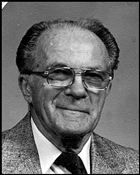 Louis
F. Granitz (Louie), 92, of Allentown, PA entered into eternal rest on Saturday, December 18, 2010. Born in Allentown, he
was the son of the late Alois and Mary (Holler) Granitz of Deutsch Minihof, Burgenland, Austria. He was predeceased by his
wife Matilda M. (Groff) Granitz. Louis was a U.S. Army World War II veteran who served in the 524th Engineer Topographic
Co. As a decorated veteran, he received the Asiatic Pacific Service Medal and European African Middle Eastern Service
Medal. Louis was a 1937 graduate of Allentown Central Catholic High School and a 1962 graduate of Community College and
Technical Institute, Allentown. Louis retired with 20 years of service in 1982 from Mack Trucks, Allentown, where he was a
machinist at plant 3C. He was previously employed with Fabricators Dye Works, Phillipsburg and L.F. Grammes Mfg,
Allentown, as a punch press operator. Louis was a lifetime member of Sacred Heart of Jesus Catholic Church in Allentown.
Louis was a member of the Mack Trucks Retirees, UAW#677 Retirees, VFW Post #13, BCTWU (Bakers) Retirees Group, Lehigh
County Senior Citizens and the former Pilots Club at Allentown airport. A strong-minded gentleman, he relished his own
home and independence. He enjoyed world traveling, dancing, outdoor walks and had a special affection for his cats. In
order to live a healthier, more vibrant life, Louis was a regular Senior Water Aerobics participant at the Allentown Boys
Club and Muhlenberg College and exercised weekly at Optimal Fitness-Good Shepherd, Allentown. He will be lovingly
remembered by his devoted daughters, Marlene and Carol. Louis
F. Granitz (Louie), 92, of Allentown, PA entered into eternal rest on Saturday, December 18, 2010. Born in Allentown, he
was the son of the late Alois and Mary (Holler) Granitz of Deutsch Minihof, Burgenland, Austria. He was predeceased by his
wife Matilda M. (Groff) Granitz. Louis was a U.S. Army World War II veteran who served in the 524th Engineer Topographic
Co. As a decorated veteran, he received the Asiatic Pacific Service Medal and European African Middle Eastern Service
Medal. Louis was a 1937 graduate of Allentown Central Catholic High School and a 1962 graduate of Community College and
Technical Institute, Allentown. Louis retired with 20 years of service in 1982 from Mack Trucks, Allentown, where he was a
machinist at plant 3C. He was previously employed with Fabricators Dye Works, Phillipsburg and L.F. Grammes Mfg,
Allentown, as a punch press operator. Louis was a lifetime member of Sacred Heart of Jesus Catholic Church in Allentown.
Louis was a member of the Mack Trucks Retirees, UAW#677 Retirees, VFW Post #13, BCTWU (Bakers) Retirees Group, Lehigh
County Senior Citizens and the former Pilots Club at Allentown airport. A strong-minded gentleman, he relished his own
home and independence. He enjoyed world traveling, dancing, outdoor walks and had a special affection for his cats. In
order to live a healthier, more vibrant life, Louis was a regular Senior Water Aerobics participant at the Allentown Boys
Club and Muhlenberg College and exercised weekly at Optimal Fitness-Good Shepherd, Allentown. He will be lovingly
remembered by his devoted daughters, Marlene and Carol.Survivors: Daughters Carol A. Granitz DeMarco (wife of Albert) of Warrington, PA and Marlene E. Granitz (companion of Charles D. Hensley) of Collingswood, NJ. Robert and Joshua DeMarco of Philadelphia, nieces and nephews in Pennsylvania and Burgenland, Austria. Services: Tuesday, December 28. Mass of Christian Burial, 10 a.m. in Sacred Heart of Jesus Catholic Church, 336 N. 4th Street, Allentown, PA 18102. Interment immediately follows at Sacred Heart of Jesus Catholic Cemetery 201 Fullerton Ave. Whitehall, PA. Relatives and friends are invited to a visitation from 8:30 a.m. to 9:30 a.m. at Bachman, Kulik & Reinsmith Funeral Home 1629 Hamilton Street, Allentown, PA. Contributions: Memorial donations may be made to Sacred Heart of Jesus Catholic Church at the above address or the no-kill shelter, the Center for Animal Health & Welfare, 1165 Island Park Rd, Easton, PA 18042. Published in Morning Call on December 22, 2010 [Ed. Note: This obit was provided by VP Klaus Gerger. He wrote, "Hi Tom, this time I have an obit of our family. Lewis Granitz - he was the son of my grandfather's sister, Maria Holler - died with the age of 92. He lived as (one of) the last Burgenlaender descendants in the old Burgenland neighborhood in 4th N Street of Allentown. Contact with the family broke after WW-2, since nobody of the family in Allentown could speak German. I reestablished contact and visited Louis and his daugthers in 2008 as a little family reunion. Thanks, Klaus] Rosalia Neumüller  Rosalia
Neumüller, 96, of Lake Villa, Illinois, passed away on Saturday, Jan. 8, 2011, at the Hillcrest Retirement Village in
Round Lake Beach. She was the wife of the late Ulrich Neumüller, who died in 1996. Rosalia
Neumüller, 96, of Lake Villa, Illinois, passed away on Saturday, Jan. 8, 2011, at the Hillcrest Retirement Village in
Round Lake Beach. She was the wife of the late Ulrich Neumüller, who died in 1996.She was born in Rábafüzes/Raabfidisch, Hungary, on Feb. 23, 1914, the daughter of the late Franz and Maria (Kroboth) Schanta and was one of 14 children. She lived in Lake Villa since 1969, and was a homemaker. She was a member of St. Bede Catholic Church in Ingleside. She is survived by her children, Gabriella (Frank) Tardin, Ferdinand (Anna), Emil (Cherie) and Johann (Noreen); grandchildren, Frank, Alfred, Ronald, Donna, David, John A., Cynthia, Richard and Robert; and her great-grandchildren, Nicole, Francis, Jason, Sheana, Katelyn, Lindsey, Kyle, Ashley and Matthew; sisters, Gisela Simitz of Coplay, PA, and Margareta Schanta of Whitehall, PA. She was preceded in death by sons Ulrich (the late Marcia) and Frank. Funeral services will begin at 9:15 a.m. Thursday, Jan. 13, from at Ringa Funeral Home (www.ringafuneralhome.com), 122 S. Milwaukee Ave. in Lake Villa, processing to St. Bede Catholic Church in Ingleside, for a 10 a.m. funeral Mass, with Rev. John Ryan officiating. Interment will be at St. Mary’s Cemetery, Fremont Center. Visitation will be at the funeral home on Wednesday, from 4 to 8 p.m. Published in the Chicago Suburban Daily Herald on January 11, 2011 Karl Reichstadter  Karl
Reichstadter, 97, of Lehighton, Pennsylvania, died Thursday, January 13, 2011, at Mahoning Valley Nursing & Rehab Center. Karl
Reichstadter, 97, of Lehighton, Pennsylvania, died Thursday, January 13, 2011, at Mahoning Valley Nursing & Rehab Center.Born January 28, 1913 in Rohrbach an der Teich, Burgenland, Austria, he was the son of the late Josef and Josefine Reichstadter and husband of the late Rosa (Bodisch) Reichstadter. He and his wife were the owners and operators of Reichstadter’s Meat Market for over 25 years before retiring in 1975. Karl was a member of Sacred Heart Roman Catholic Church, Palmerton. Survivors: Daughter, Rita Veronica Hoppes and son, Karl R. Reichstadter, both of Lehighton, PA. Services: Graveside services will be private at the convenience of the family. Arrangements are being handled by Campton Funeral Home, Inc., 525 Delaware Avenue, Palmerton, PA. Contributions: May be made in his memory to Sacred Heart R.C. Church memorial fund. Online condolences may be made at schislerfuneralhomes.com. Published in the Morning Call on January 15, 2011 |
||||||||||||||||||||||||||||||||||||||||||||||||||||||||||||||||||||||
END OF NEWSLETTER |
||||||||||||||||||||||||||||||||||||||||||||||||||||||||||||||||||||||
NOTICE (Terms and Conditions): The Burgenland Bunch (BB) was formed and exists to assist Burgenland descendants in their research into their heritage and, toward that end, reserves the right to use any communication you have with us (email, letter, phone conversation, etc.) as part of our information exchange and educational research efforts. • If you do not want your communication to be used for this purpose, indicate that it is "confidential" and we will abide by that request. • Correspondents who communicate with the BB without requesting confidentiality retain their copyright but give a non-exclusive license to the BB allowing us to forward to BB members, publish in our monthly newsletter or on our website, and/or subsequently and permanently archive all or parts of such communications. The Burgenland Bunch homepage (website) can be found at: http://www.the-burgenland-bunch.org/ Burgenland Bunch Newsletter, copyright © 2011 by The Burgenland Bunch All rights reserved. Permission to copy excerpts granted if credit is provided. |
 News
News